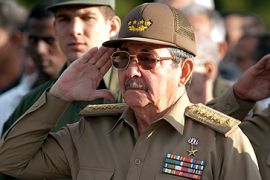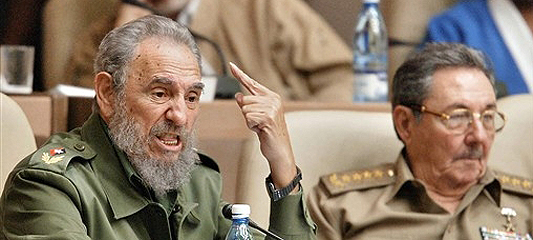Profile: Raul Castro
Al Jazeera profiles the Cuban president who took over from his brother, Fidel.

 |
| Raul Castro, right, once seemed content in his brother’s shadow [GALLO/GETTY] |
After formally taking over from his brother, Fidel Castro, as leader of Cuba, Raul Castro was swift to implement some small, but significant changes.
Raul, 77, had already been running the country since the ailing Fidel handed over power – at the time “temporarily” – in 2006 following intestinal surgery.
His decision to relax restrictions on owning mobile phones and computers, abandon pay equality and raise salaries and state pensions were welcomed by many Cubans suffering under the trade embargo imposed by the US.
Raul had seemed content to live in his brother’s shadow, and was perceived by many to lack the charisma and verve of Fidel.
However commentators say Raul has adopted a more pragmatic approach as Cuba enters a new era.
Political youth
Born on June 3 in 1931 to a Cuban mother and Spanish father, Raul was to share many formative experiences with his brother – beginning with their expulsion from school at a young age.
Politically active in his youth, he studied social sciences at college and joined the Socialist Youth, an affiliate of the Soviet-oriented Cuban communist party, the Partido Socialista Popular (PSP).
In March 1952, Fulgencio Batista, a former president overthrew the government in a coup and Fidel formed an underground movement aimed at toppling his government.
 |
| Raul, left, is thought to have introduced Fidel to Che Guevara, right [AFP] |
Both Raul and Fidel took part in the assault on Cuba’s Moncada military barracks in 1953 – an attempt to oust the authoritarian Batista government.
However the assault failed and Raul was sent to prison alongside his brother, serving 22 months behind bars.
On release, the pair went to Mexico to prepare the landing of the boat “Granma”, loaded with fighters opposed to the Batista government, on December 2, 1956 in Cuba.
Raul is widely believed to have first met and befriended Che Guevara, the famous revolutionary figure, in Mexico and introduced him to Fidel.
Guevara in turn joined Castro’s 26th July Movement – named after the date of the Moncada barracks attack – in its battle against Batista.
When the Batista government fell in January 1959, Raul became second in command and head of the country’s armed forces.
One of his first roles was reportedly to oversee the executions of soldiers loyal to Batista.
Military architect
Shortly after the revolution, Raul married Vilma Espin, another revolutionary fighter, with whom he remained until her death in June 2007. They had four children.
Raul has since shaped Cuba’s Revolutionary Armed Forces (FAR) into a complex institution, primarily as a bulwark against any potential US invasion.
As military commander, Raul was forced to adjust to considerable challenges after the 1991 collapse of the Soviet Union, Cuba’s main financial backer.
He ordered the Cuban military to form several businesses including a tourism corporation that runs a domestic airline, hotels, retail outlets and marinas.
He also has played an important role in setting domestic and budgetary policies.
Now the brother who for so long was content to work behind the scenes has settled in to running Cuba in his own way.